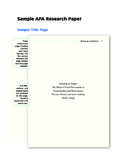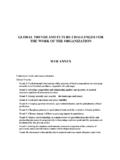Transcription of Trauma Ultrasound and the FAST exam - lbstack.com
1 Trauma Ultrasound and the fast exam Geoffrey E. Hayden, MD. Director of Emergency Ultrasonography Vanderbilt Emergency Medicine fast (Focused Assessment with Sonography for Trauma ). Why the fast exam? Studies have shown that 20-40% of patients with significant abdominal injuries may initially have a normal physical examination of the abdomen To determine, non-invasively and rapidly, the presence of free intraperitoneal or pericardial fluid in the setting of Trauma Indications: acute blunt or penetrating torso Trauma , Trauma in pregnancy, pediatric Trauma (details below), and subacute torso Trauma Patient population of particular interest: Hemodynamically unstable Unexplained hypotension in the setting of an equivocal PE.
2 PE limited Triage in disaster situations In general, studies describe sensitivities of 69-95%; Spec 95-100%1-8. Rozycki et al (79% and )1. Ma and Mateer (Sens=90% and Spec=99%; accuracy 99%)9. All patients placed in Trendelenburg and Morison's pouch (RUQ) was scanned: Sens=82%, Spec=94%, Accuracy=91%. May also improve yield with right lateral decubitus position For detecting a pericardial effusion or hemothorax, the sensitivity of sonography approaches 100%10-13. Pneumothorax studies: a single Ultrasound study of the anterior thorax was 95% sensitive and 100% specific for PTX14.
3 Pediatric Trauma is a different issue: 31-37% of children with solid organ injuries do not have associated hemoperitoneum Sensitivity of fast in children ranges 30-80%; specificity ranges 95-100%. Time: Average time to perform a fast exam is 2-4 minutes Basic overview of hemorrhage and Ultrasound : Hemorrhage evolves sonographically First it is sonolucent Clot forms in 0-4 hours (more echogenic). Becomes more sonolucent with fibrinolysis over 12-24 hours Free fluid: Appears pointy . Forms around bowel and viscera This is in contrast to the rounded fluid seen within the lumens of vascular and GI tract structures Free fluid collections: Free intraperitoneal fluid tends to collect in areas formed by peritoneal reflections and mesenteric attachments The right paracolic gutter connects morison's pouch with the pelvis The left paracolic gutter is shallower; its course to the splenorenal recess is blocked by the phrenicocolic ligament.
4 Thus, free fluid will tend to flow via the right paracolic gutter since there is less resistance Overall, the rectovesical pouch is the most dependent area of the supine male and the pouch of Douglas is the most dependent area of the supine female Free intraperitoneal fluid in the LUQ will tend to accumulate in the left subphrenic space first (not the splenorenal recess) due to the phrenicocolic ligaments; only on rare occasions, when large amounts of fluid are present, will free fluid occur between the spleen and the kidney The phrenicocolic ligament restricts the flow of free fluid between the left paracolic gutter to the LUQ, so fluid actually spreads across the midline into the RUQ.
5 The Basic fast Exam: 1. Pericardial (cardiac). 2. Perihepatic (RUQ). 3. Perisplenic (LUQ). 4. Pelvic (Pouch of Douglas or retrovesicular). Though there is no standard order for performing the fast exam, the exam will presented in the order stated above **Some advocate an additional study of the pleura to r/o pneumothorax Pericardial view: Description: Look at the interface between the right ventricle and the liver to identify pericardial fluid Cardiac tamponade identification is the immediate aim of this study A little fluid (non-circumferential) may be completely normal Circumferential pericardial fluid +/- RV or RA collapse is concerning Sono technique.
6 Probe in the subxiphoid area and angled toward the patient's left shoulder, with the pointer at 9 o'clock Transducer is almost parallel to the skin of the torso Press firmly just inferior to the xiphoid May need to move the transducer further to the patient's right in order to use the liver as an acoustic window Normal pericardium is seen as a hyperechoic (white) line surrounding the heart Pitfalls: A pericardial fat pad can be hypoechoic or contain gray-level echoes; almost always located anterior to the right ventricle and is not present posterior to the left ventricle Small pericardial fluid (non-circumferential) may be normal; do not immediately ascribe hypotension to a small amount of pericardial fluid Scan may be limited by obesity, protuberant abdomen, abdominal tenderness, gas, as well as pneumoperitoneum/pneumothoraces Sometimes hard to differentiate pleural fluid versus pericardial fluid Pearls: Transducer should be flat to the skin (overhand technique with probe).
7 Have the patient take a breath in and hold it . If the subxiphoid window is not available, may substitute with the parasternal long or short axis; know your alternatives Perihepatic view (RUQ): Description: Evaluating Morison's pouch=potential space between the liver and the right kidney 4 areas to evaluate for free fluid : Pleural space Sub-diaphragmatic space Morison's pouch Inferior pole of the kidney/paracolic gutter Sono technique: Probe indicator in the subcostal window points cranially (stay midclavicular, fluid is dependent).
8 Probe indicator in the intercostal window should point toward the right posterior axilla along the angle of the ribs (oblique angle). Right intercostal oblique and right coronal views: evaluate for right pleural effusion, free fluid in Morison's pouch, and free fluid in the right paracolic gutter The paracolic gutter may be visualized by obtained by placing the transducer in either the upper quadrant in a coronal plane and then sliding it caudally from the inferior pole of the kidney The liver appears homogenous, with medium-level echogenicity; Glissen's capsule is echogenic The kidneys have a brightly echogenic surface (Gerota's fascia).
9 Pitfalls: Perinephric fat is a mimic for hematoma Duodenal fluid, the gallbladder, and the IVC are all mimics for free fluid (follow these carefully). Pearls: Perinephric fat has even thickness (not pointy), and is symmetric with the opposite kidney Pleural fluid will present as an anechoic strip superior to the diaphragm, instead of the usual mirror artifact . Perisplenic view (LUQ): Description: 4 areas to evaluate for free fluid : Pleural space Sub-diaphragmatic space Splenorenal recess Inferior pole of the kidney/paracolic gutter Sono technique: Reach across the patient Probe indicator should point toward the left posterior axilla along the angle of the ribs (oblique angle, pointer toward 2 o'clock).
10 Think more posterior and more cephalad than would be expected The left intercostal oblique and left coronal views may be used to examine for left pleural effusion, free fluid in the subphrenic space and splenorenal recess, and free fluid in the left paracolic gutter The spleen has a homogenous cortex and echogenic capsule and hilum Pitfalls: Fluid-filled stomach can mimic fluid, as can loops of bowel and perinephric fat (see above). Pearls: Posterior posterior posterior Angle probe with ribs Pelvic view: Description: Evaluating for free fluid around the bladder Most dependent part of the abdomen (though RUQ is still the most sensitive for FF).





